Why 700C wheels DON’T roll faster

These days, it’s widely accepted that 700C wheels roll faster than smaller hoops. It’s a bit like the old belief that narrower tires are more efficient – so self-evident that it doesn’t even need explaining. After all, simple physics tells you: A bigger wheel rolls faster, because it hits bumps at a shallower angle, and it bridges small holes better, too.
It’s just that we’ve been unable to confirm this supposed superiority in the real world. In Bicycle Quarterly’s tire tests, we’ve tested different wheel sizes in a number of tests. Our first tire tests included roll-downs of identical tires in 700C and 650B wheel sizes. We later ran 700C, 650B and 26″ tires on smooth pavement and a very rough surface (rumble strips of a highway) with a power meter. We also ran them on a track, again with a power meter. The results are always the same: There is no measurable difference in how fast the three common wheel sizes (26″, 650B, 700C) roll on real roads – paved or gravel, even cobblestones – as long as you keep the casings, tread and other factors the same. In other words, a 650B x 38 mm Rene Herse tire is as fast as a 700C x 38, and so on.
So what about the physics? Why doesn’t a big wheel roll faster? Let’s try to figure this out…
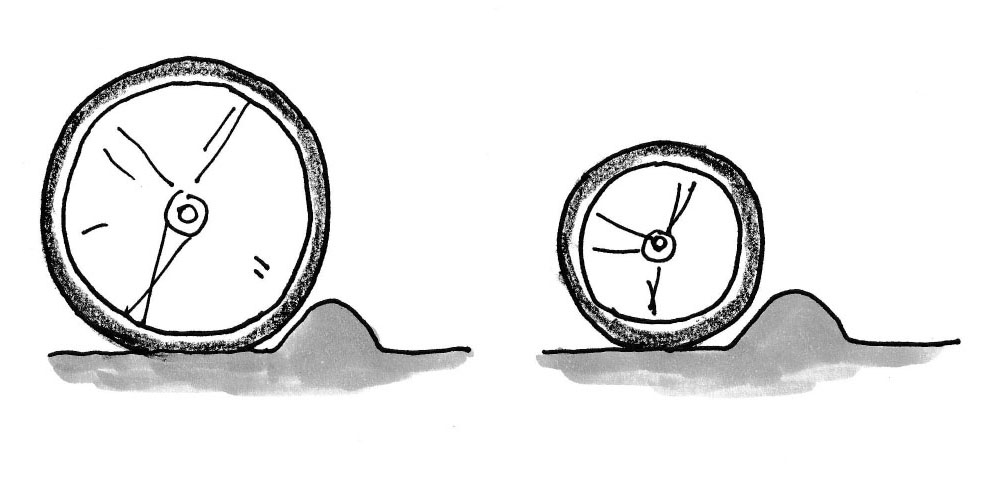
With a solid wheel, it’s easy to see why the big wheel on the left rolls more easily over the same-size bump than the small wheel on the right. By making the wheel larger, you make the bump smaller in relation to the wheel. Everybody knows that it’s easier to go over small bumps than over big bumps. The same applies to holes – a larger wheel makes the hole smaller.

That’s why horse-drawn carriages had very large wheels. It allowed them to travel faster and more comfortably over rough roads. It’s important to note that the carriages had solid wheels that were (almost) completely round, which made the physics very simple.
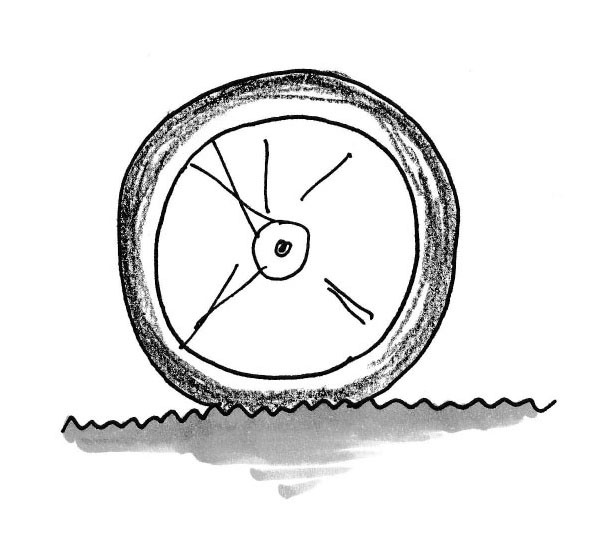
So why don’t cars and buses (and bikes) have huge wheels, too? It’s because their wheels aren’t solid. A wheel with air-filled tires behaves differently. It is not round, but flat at the bottom. The weight of rider and bike flattens out the tire where it touches the road surface.
Small obstacles are absorbed by flex in the tire, not by lifting the entire vehicle over them. How fast the wheel rolls is determined by how much energy the tire consumes as it goes from round to flat, and back to round again with each revolution of the wheel. Wheel size doesn’t really matter as long as the bumps are small enough so they can be absorbed by the tire.
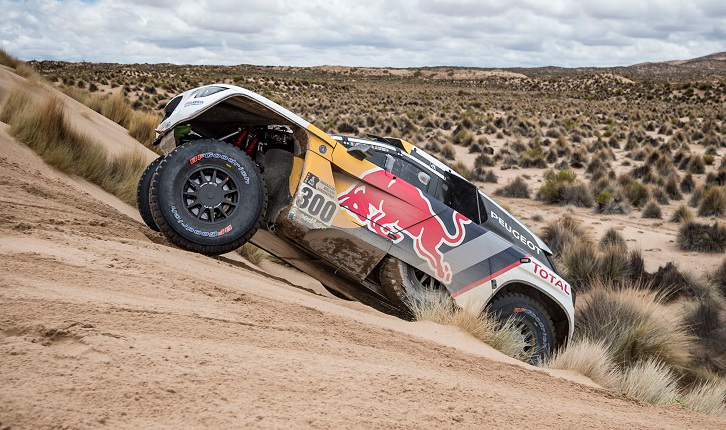
If you want to absorb bigger bumps, you make the tire taller/wider, not the rim bigger. A good illustrations are off-road race cars. Looking at the winner of the famous Dakar Rally (above), the first thing we notice are the huge wheels. But when we look closely, we see that the rims are relatively small. In fact, they are as small as possible: The brakes have to fit inside the rims. Look at the front wheel, and you can see the (silver) brake rotor filling almost the entire rim, with just enough clearance for the brake caliper. The rims can’t get any smaller without giving up braking performance.
So we’ve got small rims with huge tires, designed to absorb bumps without the wheel having to go up and over each bump.

The same is true for bikes: Especially on rough terrain, a bigger tire on a smaller rim will roll faster than a narrow tire on a large rim. In other words, a 650B x 48 mm tire will roll faster than a 700C x 28, even though both have the same diameter. (Or in the photo above, a 26″ x 2.3″ compared to a 700C x 23 mm.)
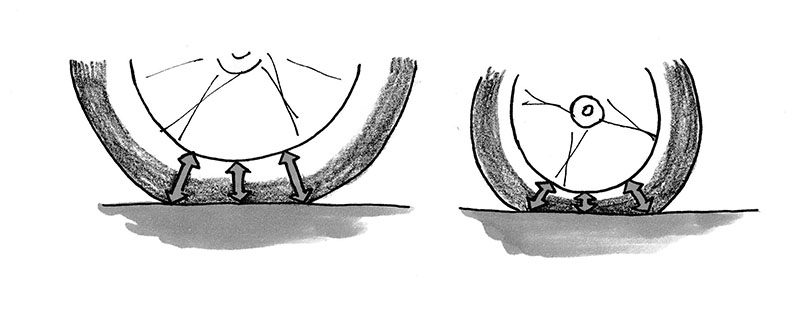
What if we keep the tire width the same – say 48 mm – and just make the rim (and hence the entire wheel) larger? For example, what if we compare a 700C x 48 tire with a 650B x 48?
In that case, there is a factor that could make larger wheels faster: The shape of the contact patch is different. For a given tire construction, air pressure and load, the tire’s contact patch will be the same size. If the tires have the same width, the contact patch will also have the same length. On a larger wheel (left), this means that the tire doesn’t have to flex as much as on a smaller wheel (right).
Look at how close the rim comes to the road surface, which shows how deeply the tire deflects: The small wheel (right) flexes the tire until it’s about 50% as tall as it is unloaded. The large wheel (left) flexes much less. And less tire deformation means smaller hysteretic losses and less rolling resistance.
For the same reason, wider tires faster. (In that case, the contact patch is shorter, so the tire also deflects less.) So in theory, the wheel with the lowest rolling resistance is the tallest and widest you can fit into your frame. In practice, once your tires are tall enough and wide enough, the benefits of going wider/taller is too small to be of any importance – which is why we can’t measure it. It’s also possible that the benefits of larger wheels are canceled by their increased air resistance.
It’s important to remember that the common wheel sizes are very close in diameter. The smallest 26″ wheels are just 10% smaller than the largest 29er/700C wheels. It’s not a big difference… And the drawings showing the tire deformation are exaggerated – in the real world, tires don’t deform that much.
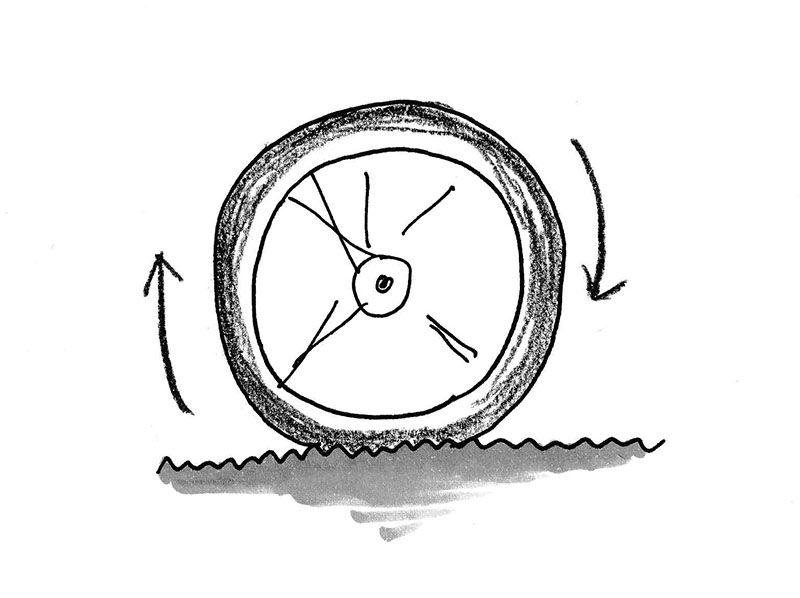
The important question is not
How much does the tire deform?
but
How much energy does it take to deform the tire?
And that is where supple casings come in. The difference in energy absorption between a stiff and a supple casing is much greater than all other effects, for a number or reasons:
- A supple tire needs less energy to go from round to flat and back to round again.
- A supple casing makes the tire absorb bumps better without lifting the entire bike. A stiff casing behaves more like a solid wheel.
- A supple tire reduces the suspension losses that are caused by vibrations of the bike.
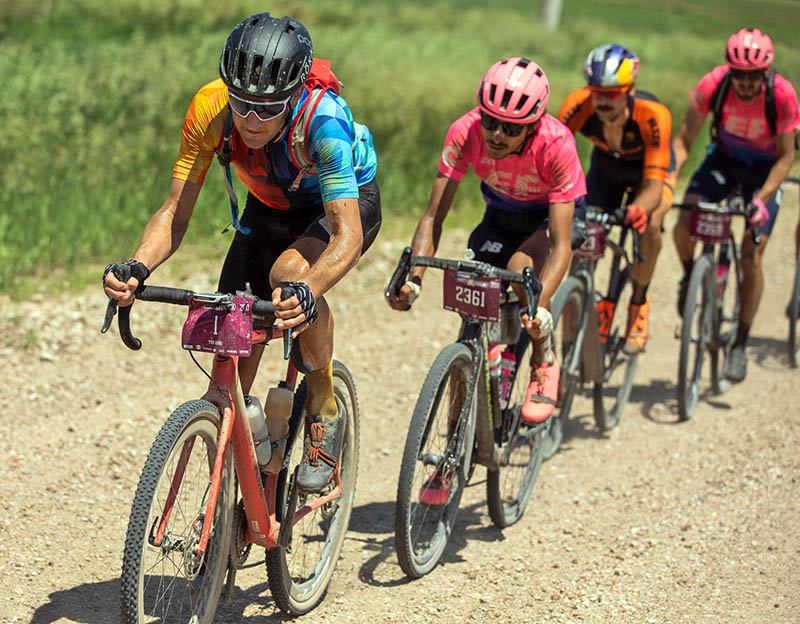
At this point, you may think: “I understand that the effect of wheel size is small. And yet, once you’ve optimized your tire casings and everything else, why wouldn’t you run 700C wheels? It seems that they are faster, even if it’s too small to measure in the real world. What is the down side?”
If you’re lining up with racers like Ted King (No. 1), Lachlan Morton (2361) and Payson McElveen (2361), you’ll need any advantage you can get, even if it’s mostly psychological. If you’re running tires in the 38-44 mm range, like most gravel racers, there’s little to lose by running 700C wheels. Since everybody else tends to run them, it makes sense to do so as well, just in case we’ve overlooked something in our analysis. If you don’t worry about making the wrong wheel choice, you can focus your energy on winning the race. It’s a bit like replacing your water bottle screws with titanium ones – it can give you the confidence that you’ve done all you can to optimize your equipment.
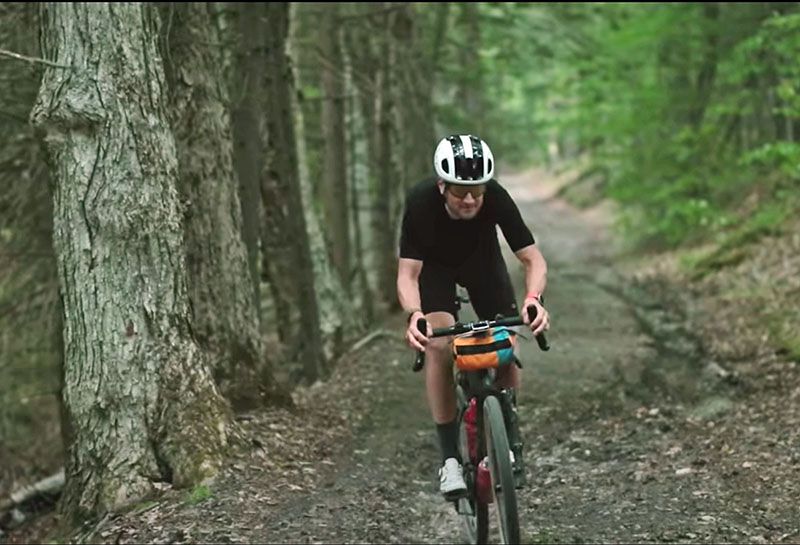
Then why would anybody run 650B wheels? There is an advantage to the smaller wheels: You can fit wider tires on your bike. And as we’ve seen above, wider tires can absorb larger bumps and roll faster over rough terrain. A second benefit is that the smaller wheels make the bike more nimble, which helps during fast, twisty descents. Huge 700C tires will make your bike more stable, which may be desirable for a 29er mountain bike, but can make an all-road bike tricky to handle during fast, twisty descents.
Ted King’s tire choices illustrate this. For last year’s big gravel races, he ran our 700C x 38, 42 and 44 mm tires with great success. This summer, he’s on 650B x 48 mm Rene Herse Switchback Hill tires. A few weeks ago, he rode more than 300 miles non-stop across the state of Vermont, almost entirely on dirt roads. He reports that he felt faster than ever, because extra air is more important than extra wheel diameter, and supple casings have greater benefits than both.
Once gravel races start up again, we’ll see what tires he’ll choose. I wouldn’t be surprised if he’s back on 700C, because he doesn’t need to worry about whether his wheels are faster or slower than his competitors’ on any given section of the course. Or perhaps he’ll continue to ride his 650B wheels, because he’ll want to keep the advantage that the wider tires give him on rough ground.
Conclusion: Dial in your wheels based on how you want your bike to feel. Run 700C wheels if you like, but don’t worry about giving up speed if you are on 650B. Just make sure your tires are supple.
Credits: Ansel Dickey (Image 1, 9, 10); Natsuko Hirose (drawings); Peugeot (Image 5)


